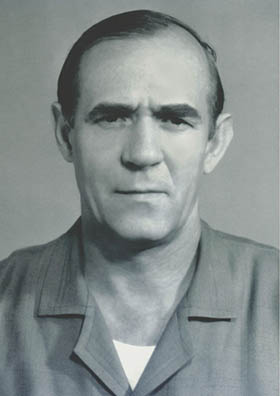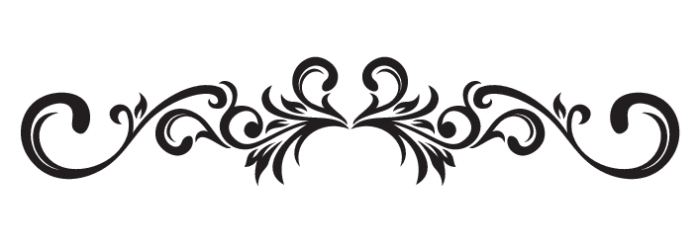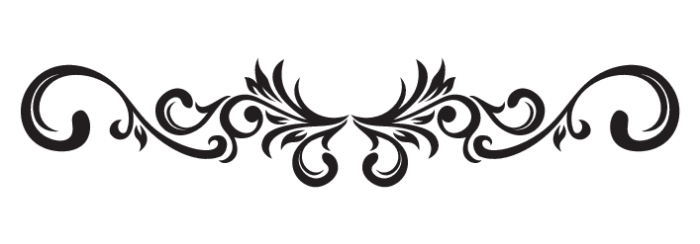The liberation of the cities of Ukraine from the Nazi invaders
Zaporozhye during the Great Patriotic War
On August 18, 1941, two months after the beginning of the war, the Nazis approached the city Zaporozhye. At that time, dozens of large factories, light industries, institutes, theaters, and museums worked in the city. It was impossible to let the enemy into the city before the evacuation of these objects. For month and a half the city’s defense was exerted at the cost of an incredible effort. At that time, all forces were thrown into the evacuation of industrial and cultural property. On October 4, 1941 the Red Army left the city. The occupation of the city lasted almost two years. These were the tragic pages of the history of Zaporozhye.
During that time, the Germans killed 43 thousand people. Many young people were hijacked to Germany for forced labor. There was a concentration camp in the city. The Nazis carried out massive executions of Jews.
After the liberation of Zaporozhye, the restoration of the national economy began at an incredible pace. Roads, collective farms, the Dnieper hydroelectric station dam, and Zaporozhye industrial giants were restored. Only three and a half years after the liberation of the city, blast furnaces of Zaporozhstal produced the first cast iron.
The theme of Zaporozhye during the Great Patriotic War was reflected in the works of P. Redin. Some of his earliest works are preserved in the Zaporozhye Regional Lore Museum. At those paintings you can see the evacuation of Zaporozhye plants, the atrocities of the invaders in the city, and the enthusiasm of restoring of the industrial giants.
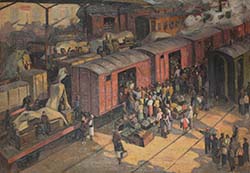
The planned evacuation
Oil on canvas
The 1940s
17 x 25 in.
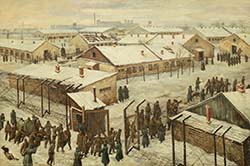
Concentration camp for prisoners of war
in the Zaporozhye factory №29
Oil on canvas
The 1940s
20 x 31 in.
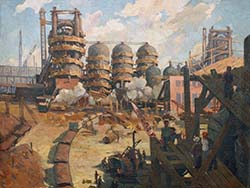
Recovery of industry,
destroyed by the German occupiers
Etude
Oil on canvas
The 1940s
19 x 26 in.
Breakthrough of the German defensive line "Wontan"
Wontan is a line of German fortifications which was erected in the area from the Dnieper River to the banks of the Azov (Molochny Liman).
The assault of this line began on September, and the breakthrough came on October, 1943. After the breakthrough of the Wontan line, the Red Army troops reached the banks of the Dnieper in southern Ukraine and the northern borders of the Crimea.
Heavy, bloody battles on the banks of the Molochnaya River are depicted on the large-scale diorama of the Melitopol City Museum “Breakthrough of the German defensive line 'Wontan' on October, 1943."
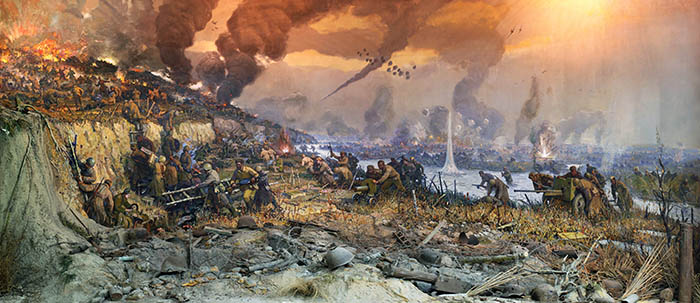
The breakthrough of the German defense line "Wotan" in October, 1943. Diorama
(authors: V. Parchevsky, P. Redin, Y. Smirnov, P. Nikiforov)
Melitopol City Historical Museum
1971-1972
L 41ft., H 13ft.
The liberation of the city of Zaporozhye from the Nazi invaders
The Zaporozhye operation was a military operation of the great Battle for the Dnieper. Its goal was the elimination of German troops and the liberation of the city of Zaporozhye.
The assault of the city began on October, 13 at 10 p.m., and by 2:00 a.m. units of the 23rd tank corps of Red Army broke into the southern outskirts of the city. Lieutenant Nikolai Yatsenko’s tank was the first to break into the city. The crew of the tank destroyed 4 enemy tanks, several firing points, over 100 Nazis, and captured the bridge over the Mokra Moskovka River. Badly wounded tankers fired at the Nazis until the last minute of their live. Despite the fierce resistance of the Germans, the city of Zaporozhye was liberated by the end of the day on October 14. For his courage, M. Yatsenko was posthumously awarded the title Hero of the Soviet Union.
The painting of P. Redin "First tank landing party" was dedicated this legendary hero, the liberator of Zaporozhye. The small canvases of the artist also depict the battles of that October night of the 43rd year - at the South Station (Zaporozhye Station I), and at the city mill near the Moskovka River. Despite the fierce resistance of the Germans, by the end of the day on October, 14 the city of Zaporozhye was liberated, and the bridgehead of the German troops was liquidated.

Exemption of Zaporozhye from Nazi invaders
The first tank landing
Oil on canvas
1961
23 x 78 in.
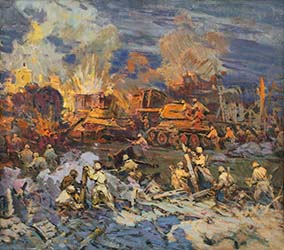
Battle near South Station
in Zaporozhye. October, 1943
Oil on canvas
1962
15 x 17 in.
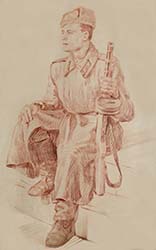
Defender of the Motherland
Drawing
Pencil on paper
14 x 8 in.
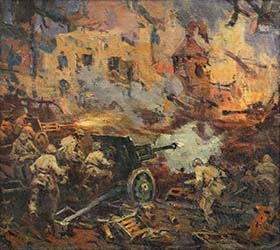
On bridgehead near
the river Moscovka. October, 1943
Oil on canvas
1962
15 x 17 in.
Drawings and caricatures
After the war, the theme of artistic posters, drawings, caricatures was very popular in various newspapers, magazines, and book publications. P. Redin participated in this work. Some of his drawings and caricatures devoted to the occupation and post-war reconstruction of the city are preserved in the Zaporozhye Regional Lore Museum.
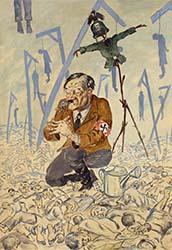
Hitler - the gardener
caricature drawing
Gouache on paper
The 1940s
23 x 15 in.
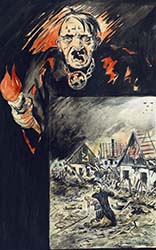
Promised land
drawing of German cemetery
Gouache on paper
The 1940s
19 x 11 in.
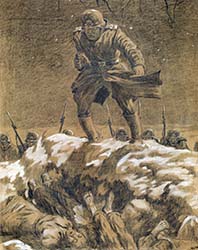
The killers
drawing
Gouache on paper
The 1940s
21 x 17 in.
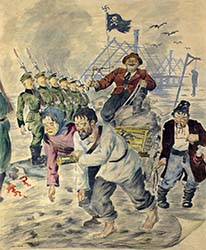
Colonialists
caricature drawing
Gouache on paper
The 1940s
22 x 17 in.
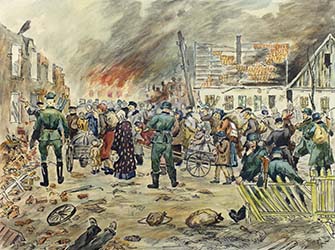
The expulsion of young people
and the population of Zaporozhye
drawing
Gouache on paper
The 1940s
12 x 17 in.
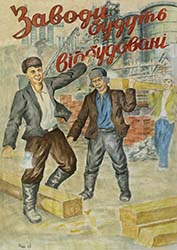
The plants will be restored
Poster
Gouache on paper
The 1940s
23 x 15 in.
Triptych "From the history of the Motherland"
The triptych "From the history of the motherland" is dedicated to the image of the soldier - defender of the motherland.
The paintings of P. Redin show different epochs, and different events. We can see the soldiers of the Old Slavic squads fighting for their land, the soldiers fighting for people's power, and the soldiers the winners of Nazism. All of them have the same goal - to protect their country and their people at any cost. Unfortunately, one of the paintings of the triptych has not been preserved. But it can be seen on the video about the anniversary exhibition of the artist.
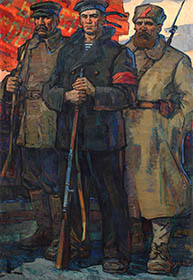
People power
Oil on canvas
1964
61 x 43 in.
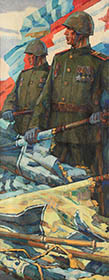
Parade of Victory
Oil on canvas
1964
61 x 23 in.
Eternal memory to a great feat
The painting of P.F.Redin "Maternal sadness" depicts a generalized image of the indelible, great memory of the heroism of Russian soldiers. A small obelisk on the bank of the Dnieper was set up in honor of the great feat of Russian soldiers who forced the Dnieper on October, 1943, freeing their native land from the Nazi invaders.
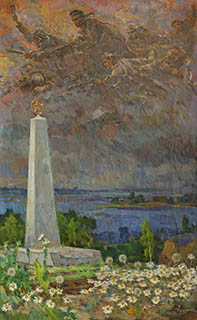
Maternal sadness
Oil on canvas
1983
49 x 30 in.
Battle near Akhtyrka
The Battle of Kursk was a Second World War engagement between German and Soviet forces on the Eastern Front near Kursk in the Soviet Union, during July and August, 1943.
Most historians, talking about the Battle of Kursk, focus on the Belgorod-Kharkov operation and only briefly mention the fierce battles on the territory of the Sumy region of Ukraine. These battles included battles near Akhtyrka.
The assault on Akhtyrka began on August 11, 1943. However, a powerful and well-prepared enemy defense did not allow the Red Army to develop a full-scale offensive on this sector.
Continuous bloody battles lasted more than ten days. During those battles there were both successes of the Soviet troops and defeats - counter enemy attacks, encirclement and destruction of units of the Red Army. Akhtyrka was liberated only on August, 25.
The large-scale diorama "At the Final Stage of the Battle of Kursk (Battle near Akhtyrka)” is dedicated to the events of August, 1943, taking place in this place. Diorama is on display in the Sumy Museum of Local Lore.
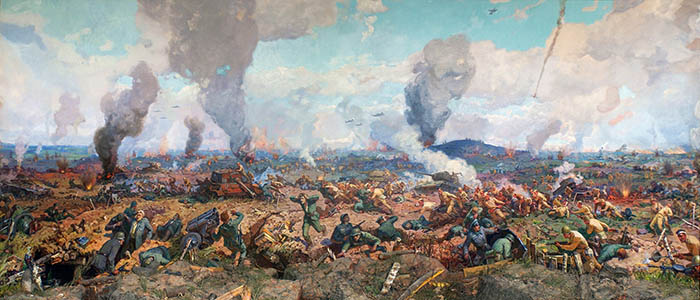
At the final stage of the battle of Kursk (battle near Akhtyrka). Diorama
(authors: E. Chuykov, P. Redin, U. Smirnov)
Sumy Historical Museum
